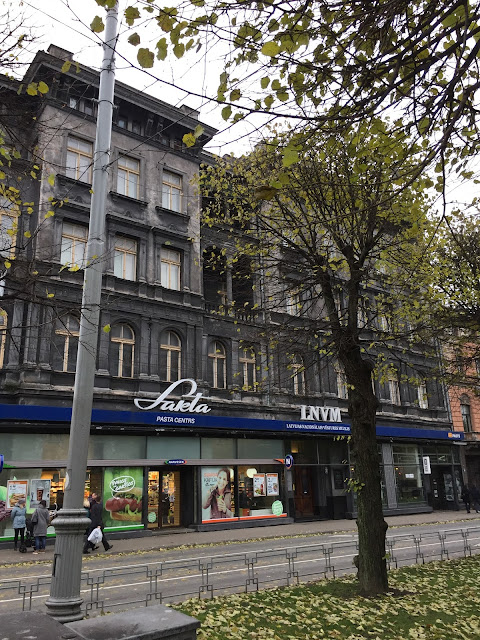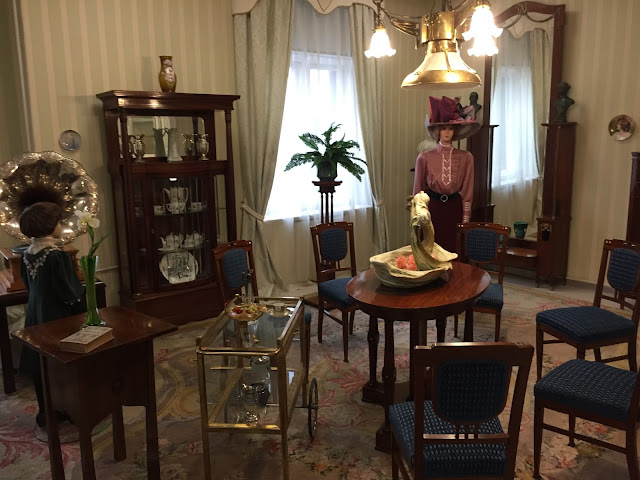197. Regional Travel #4.4 - National History Museum of Latvia
I was definitely looking forward to visiting the National History Museum of Latvia during my visit to Riga, because I have never studied the history of this part of the world. I could not have told you much about the Baltic region before coming here, other than perhaps a few facts that I picked up in news stories when the Soviet Union broke apart during the early 1990s. The museum did not disappoint - there was so much fascinating information that was new to me, and it was presented in a format that was a bit more current than some of the other Soviet-era museums in Russia and Latvia that I've visited.
The museum was established in 1869 by the Science Committee of the Riga Latvian Society, and for most of its history has been located in Riga Castle (which dates back to 1330), along the banks of the Daugava River. A fire heavily damaged the castle in 2013; fortunately, none of the museum's collections were destroyed (although some objects experienced water damage). The History Museum moved to its new home the following year: a 19th century mansion just outside and to the northeast of Old Town. The museum will eventually move back to Riga Castle, but for now the institution seems to have comfortably settled into its current location. Before I ended up here, I first tried to visit the Castle, which serves as the home of the President of Latvia but is closed to visitors while the repairs and renovations continue.
The Museum's first exhibition opened in 1894, and the displays grew over the years to present a comprehensive view of the region. The exhibits now cover the entire span of human presence in Latvia, from the first settlements 12,000 years ago to the political upheaval at the end of the twentieth century. My favorite exhibits focus on the little-known (to most Americans) medieval period in the Baltic States: the Livonian confederation of the 13th-16th centuries, and the the Duchy of Courland and Semigallia in the 16th-18th centuries. I also learned much about the the culture and identity of Latvia during the politically tumultuous twentieth century.
This turned out to be one of my favorite museums in Riga, despite the somewhat unassuming exterior of its temporary accommodations. It strikes a nice balance in its coverage of archaeology, folk art and costumes, military history, and art, and the extensive interpretation was illuminating and available in English (via or booklets) for every exhibit.
The museum visit begins with a temporary exhibit: "The Latvians: An Interpretation. Latvian Ethnographic Exhibition of 1896" -
The majority of the museum is occupied by permanent exhibits, arranged in chronological sequence. The first was "Ancient history of Latvia (10500 - 1800 BCE)"-
"Ancient peoples in the territory of Latvia (1st-12th centuries CE)" -
"Livonia (13th-16th centuries)" -
"Territory of Latvia and its Inhabitants (16th-18th centuries)" -
"The Duchy of Courland and Semigallia (1561-1795)" -
Three smaller exhibits focus on the late 19th and early 20th centuries:
1) "Living environment and daily life in the 19th century and beginning of the 20th century: interiors of Biedermeier style and Art Nouveau style"
2) "Latvians in the second half of the 19th century and early 20th century: national identity, culture, and social life"
3) "World War I and establishment of the Republic of Latvia (1914-1940)"
"Latvians abroad (1944-1990)" -
A view of Riga Castle, the official residence of the president of Latvia and the former and future home of the National History Museum of Latvia:
The museum was established in 1869 by the Science Committee of the Riga Latvian Society, and for most of its history has been located in Riga Castle (which dates back to 1330), along the banks of the Daugava River. A fire heavily damaged the castle in 2013; fortunately, none of the museum's collections were destroyed (although some objects experienced water damage). The History Museum moved to its new home the following year: a 19th century mansion just outside and to the northeast of Old Town. The museum will eventually move back to Riga Castle, but for now the institution seems to have comfortably settled into its current location. Before I ended up here, I first tried to visit the Castle, which serves as the home of the President of Latvia but is closed to visitors while the repairs and renovations continue.
The Museum's first exhibition opened in 1894, and the displays grew over the years to present a comprehensive view of the region. The exhibits now cover the entire span of human presence in Latvia, from the first settlements 12,000 years ago to the political upheaval at the end of the twentieth century. My favorite exhibits focus on the little-known (to most Americans) medieval period in the Baltic States: the Livonian confederation of the 13th-16th centuries, and the the Duchy of Courland and Semigallia in the 16th-18th centuries. I also learned much about the the culture and identity of Latvia during the politically tumultuous twentieth century.
This turned out to be one of my favorite museums in Riga, despite the somewhat unassuming exterior of its temporary accommodations. It strikes a nice balance in its coverage of archaeology, folk art and costumes, military history, and art, and the extensive interpretation was illuminating and available in English (via or booklets) for every exhibit.
The museum visit begins with a temporary exhibit: "The Latvians: An Interpretation. Latvian Ethnographic Exhibition of 1896" -
The majority of the museum is occupied by permanent exhibits, arranged in chronological sequence. The first was "Ancient history of Latvia (10500 - 1800 BCE)"-
"Ancient peoples in the territory of Latvia (1st-12th centuries CE)" -
"Livonia (13th-16th centuries)" -
"Territory of Latvia and its Inhabitants (16th-18th centuries)" -
"The Duchy of Courland and Semigallia (1561-1795)" -
Three smaller exhibits focus on the late 19th and early 20th centuries:
1) "Living environment and daily life in the 19th century and beginning of the 20th century: interiors of Biedermeier style and Art Nouveau style"
2) "Latvians in the second half of the 19th century and early 20th century: national identity, culture, and social life"
3) "World War I and establishment of the Republic of Latvia (1914-1940)"
"Latvians abroad (1944-1990)" -
A view of Riga Castle, the official residence of the president of Latvia and the former and future home of the National History Museum of Latvia:





























































Comments
Post a Comment